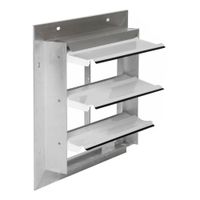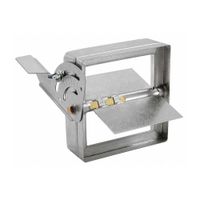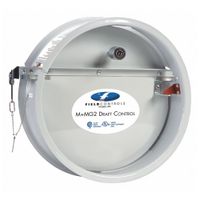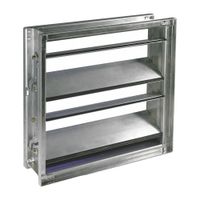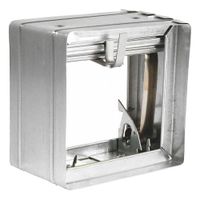Call +(254) 703 030 000 / 751 483 999 / 721 704 777
.....Read More
Frequently Asked Questions
What is the purpose of dampers in an HVAC system?
Dampers in an HVAC system are crucial components designed to regulate airflow within the system. Their primary purpose is to control the volume and direction of air distributed throughout the building, ensuring optimal comfort and efficiency. By adjusting the position of the dampers, the system can balance the airflow to different zones or rooms, maintaining desired temperature levels and improving energy efficiency.
Dampers can be either manual or automatic. Manual dampers require physical adjustment, while automatic dampers are controlled by the HVAC system's thermostat or a building management system, allowing for precise and responsive control of airflow. This automation is particularly beneficial in zoned HVAC systems, where different areas of a building may require different heating or cooling levels.
In addition to regulating airflow, dampers also play a role in air quality and safety. They can be used to isolate sections of the ductwork for maintenance or in case of a fire, preventing smoke and flames from spreading through the ventilation system. Fire dampers are specifically designed to close automatically when a certain temperature is reached, providing a critical safety function.
Furthermore, dampers help in noise reduction by controlling the flow of air, which can minimize the sound of air moving through the ducts. This contributes to a quieter and more comfortable indoor environment.
Overall, dampers are essential for the efficient and safe operation of an HVAC system, providing control over airflow, enhancing energy efficiency, improving comfort, and ensuring safety.
How do control dampers differ from balancing dampers?
Control dampers and balancing dampers serve distinct functions in HVAC systems.
Control dampers are designed to regulate airflow and are typically used in variable air volume (VAV) systems. They adjust the flow of air to maintain desired environmental conditions, such as temperature and humidity, by modulating the position of the damper blades. These dampers are often motorized and connected to a building's automation system, allowing for precise control based on real-time data. Control dampers can be used for zone control, mixing air streams, or isolating sections of ductwork.
Balancing dampers, on the other hand, are used to ensure that the correct amount of air is distributed to each area of a building. They are primarily installed during the commissioning phase of an HVAC system to achieve the designed airflow rates. Unlike control dampers, balancing dampers are typically manually adjusted and set to a fixed position once the desired balance is achieved. They are not intended for frequent adjustments and do not respond to changes in environmental conditions.
In summary, control dampers are dynamic components used for ongoing regulation of airflow, while balancing dampers are static components used to establish and maintain the initial balance of airflow within a system.
What are the benefits of using backdraft dampers?
Backdraft dampers offer several benefits in HVAC systems and ventilation applications:
1. **Prevention of Reverse Airflow**: Backdraft dampers are designed to prevent reverse airflow in duct systems. They automatically close when there is no forward airflow, stopping outside air from entering the system and maintaining indoor air quality.
2. **Energy Efficiency**: By preventing unwanted air infiltration, backdraft dampers help maintain the desired indoor temperature, reducing the load on heating and cooling systems. This leads to energy savings and lower utility bills.
3. **Protection Against Contaminants**: These dampers block the entry of pollutants, dust, and debris from outside, protecting indoor environments and improving air quality.
4. **Noise Reduction**: Backdraft dampers can help reduce noise from outside or from other parts of the building, contributing to a quieter indoor environment.
5. **Moisture Control**: By preventing the backflow of humid air, these dampers help control moisture levels indoors, reducing the risk of mold and mildew growth.
6. **Improved System Performance**: By ensuring that air flows in the intended direction, backdraft dampers enhance the overall performance and efficiency of HVAC systems.
7. **Low Maintenance**: Typically, backdraft dampers require minimal maintenance, making them a cost-effective solution for long-term use.
8. **Versatility**: Available in various sizes and materials, backdraft dampers can be used in a wide range of applications, from residential to commercial and industrial settings.
9. **Easy Installation**: Most backdraft dampers are designed for easy installation, which can save time and labor costs during setup.
10. **Compliance with Building Codes**: Using backdraft dampers can help meet building codes and standards related to ventilation and energy efficiency.
How do fire and smoke dampers function in an emergency?
Fire and smoke dampers are critical components in a building's HVAC system, designed to prevent the spread of fire and smoke through ductwork during an emergency.
Fire dampers are installed where ducts penetrate fire-rated walls or floors. They are equipped with a fusible link or a heat-sensitive device that melts or breaks at a specific temperature, typically around 165°F (74°C). When activated, the damper's blades close, forming a barrier that prevents fire from passing through the ductwork. This containment helps maintain the integrity of fire-rated barriers, allowing occupants more time to evacuate and firefighters to control the blaze.
Smoke dampers, on the other hand, are designed to restrict the movement of smoke. They are often installed in smoke barriers and are activated by a smoke detector signal or a building's fire alarm system. Upon detection of smoke, the damper's motorized actuator closes the blades, preventing smoke from spreading through the HVAC system. This containment is crucial for maintaining safe egress routes and reducing smoke inhalation risks.
Combination fire and smoke dampers perform both functions, closing in response to either heat or smoke. They are typically used in areas where both fire and smoke barriers are required.
In an emergency, these dampers work in conjunction with the building's fire alarm and control systems. Regular maintenance and testing are essential to ensure their proper operation, as any failure could compromise the building's fire safety strategy. Proper installation and adherence to building codes and standards are also critical to their effectiveness in an emergency.
What are the differences between manual and motorized dampers?
Manual dampers are operated by hand, requiring physical adjustment to control airflow. They are typically used in systems where frequent changes in airflow are not necessary. Manual dampers are cost-effective, simple to install, and require no electrical power, making them suitable for smaller or less complex HVAC systems. However, they can be less precise and require manual intervention for adjustments, which can be inconvenient and time-consuming.
Motorized dampers, on the other hand, are equipped with an electric motor that allows for automatic adjustment of airflow. They can be integrated into a building's control system, enabling remote operation and precise control over airflow. This makes them ideal for larger, more complex HVAC systems where conditions change frequently. Motorized dampers can improve energy efficiency by optimizing airflow based on real-time data, reducing the need for manual adjustments. However, they are more expensive than manual dampers, require electrical power, and involve more complex installation and maintenance.
In summary, the main differences lie in operation, cost, precision, and suitability for different system complexities. Manual dampers are simple and cost-effective but require manual adjustments, while motorized dampers offer automated, precise control at a higher cost and complexity.
How do bypass dampers work in a system?
Bypass dampers are used in HVAC systems to regulate airflow and maintain balanced pressure within the ductwork. They are typically installed in systems with variable air volume (VAV) or zoning to manage excess air when certain zones do not require heating or cooling.
When the system is in operation, the HVAC unit produces a constant volume of air. However, as individual zones reach their desired temperature, their respective dampers close, reducing the demand for conditioned air. This can lead to increased pressure in the ductwork, potentially causing noise, inefficiency, or damage to the system.
The bypass damper addresses this issue by redirecting the excess air back into the return duct or directly into the plenum. It is usually controlled by a pressure sensor or a static pressure controller that monitors the duct pressure. When the pressure exceeds a predetermined setpoint, the bypass damper opens to allow the surplus air to bypass the closed zones, thus maintaining the desired pressure balance.
Bypass dampers can be either motorized or gravity-operated. Motorized dampers use an actuator to adjust the damper position based on signals from the pressure controller. Gravity-operated dampers rely on the pressure differential to open or close, using counterweights to maintain the desired position.
Overall, bypass dampers enhance system efficiency, reduce wear and tear on the HVAC components, and ensure consistent comfort levels across all zones by preventing over-pressurization and maintaining optimal airflow.
What maintenance is required for dampers in an HVAC system?
1. **Inspection**: Regularly inspect dampers for signs of wear, corrosion, or damage. Check for obstructions that may impede movement.
2. **Cleaning**: Clean dampers to remove dust, dirt, and debris that can accumulate and affect performance. Use a soft brush or vacuum for thorough cleaning.
3. **Lubrication**: Apply appropriate lubricants to moving parts to ensure smooth operation. Avoid over-lubrication, which can attract dust and debris.
4. **Calibration**: Ensure dampers are properly calibrated to maintain correct airflow. Adjust settings as necessary to meet system requirements.
5. **Testing**: Conduct functional tests to verify that dampers open and close fully and respond correctly to control signals. Test both manual and automatic operations.
6. **Seal Inspection**: Check seals for wear or damage. Replace seals if they are cracked or not providing an adequate seal to prevent air leakage.
7. **Actuator Maintenance**: Inspect and maintain actuators, ensuring they are functioning correctly. Replace faulty actuators to maintain damper performance.
8. **Alignment**: Ensure dampers are properly aligned to prevent binding or uneven wear. Adjust as necessary to maintain alignment.
9. **Control System Check**: Verify that the control system is functioning correctly and communicating with dampers. Update software or firmware if needed.
10. **Documentation**: Keep detailed records of maintenance activities, including inspections, repairs, and replacements, to track damper performance over time.
11. **Professional Servicing**: Schedule regular professional servicing to ensure comprehensive maintenance and address any complex issues.
12. **Safety Checks**: Ensure all safety mechanisms are operational to prevent accidents or system failures.
13. **Replacement**: Replace dampers that are beyond repair or have reached the end of their service life to maintain system efficiency.
